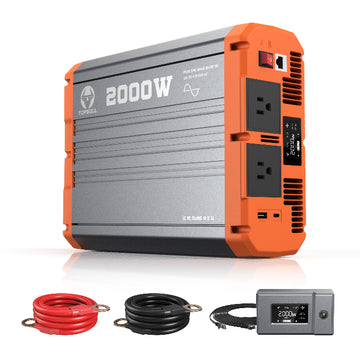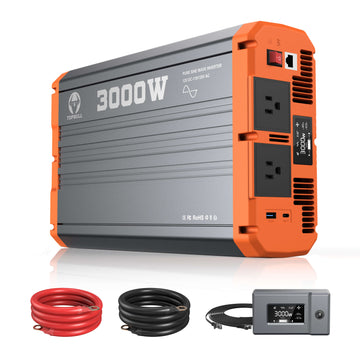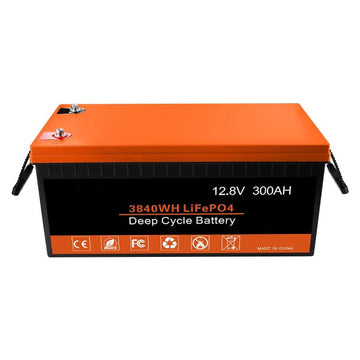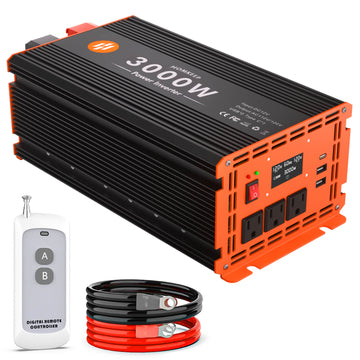With the rise of camping culture, the demand for outdoor electricity is growing.Whether it is charging mobile phones, using electric fans, making coffee or playing music, a stable power supply has become a "necessity" for modern camping.As the core device that converts direct current (DC) to alternating current (AC), the power inverter is the camper's "mobile power station".However, incorrect use of inverters can lead to equipment damage and even safety hazards.Knowing how to use your power inverter effectively will not only enhance your camping experience, but also ensure that your equipment is always in usable condition.
Understanding power inverters for camping
What is a power inverter?
A power inverter is an electronic device that converts electricity from a DC power source, such as a battery or solar panel, into standard AC power for use in household appliances.In a camping environment, inverters are often used in conjunction with on-board batteries, portable generators or solar charging systems.
Learn more about what is an inverter
Why do you need a power inverter for camping?
Charging convenience: to charge electronic devices such as mobile phones, tablets, cameras, etc.
Electrical operation: to use electrical appliances such as fans, mini-fridges, lights, etc.
Emergency Backup: Provides electrical support in case of emergency.
Selecting the right power inverter
1. Power requirements
Evaluate the power of your equipment: first list all the appliances you plan to use while camping and record their power requirements.
Select the inverter power: the power of the inverter should be slightly higher than the sum of the power of all your devices to ensure stable operation.
2. Output waveform
Pure sine wave: Suitable for all appliances, especially those requiring high power quality.
Modified Sine Wave: Suitable for most small appliances, but may not be suitable for some sensitive devices.
3. Input Voltage and Battery Type
Input Voltage: Make sure the inverter is compatible with your battery or power system.
Battery type: Consider using lithium batteries, lead-acid batteries, choose according to your needs and budget.
4. Portability and Durability
Portable design: Choose an inverter that is lightweight and easy to carry.
Durability: Consider the inverter's waterproof, dustproof and shock-resistant performance for outdoor environments.
Read more: Portable Inverter Complete Buyer's Guide
How to use a power inverter while camping
Using a power inverter while camping can make it easier for you to use a variety of electronic devices. Here are detailed steps and tips to help you use your power inverter safely and effectively:
1. Preparation
Make sure the inverter is rated higher than the total power requirements of the devices you plan to use. Check the power (wattage) on the device label and make sure the inverter can handle the maximum load of all devices.
Selecting Batteries
Deep-cycle batteries (such as lead-acid or lithium batteries) are ideal for camping because of their ability to maintain good performance over multiple charges and discharges.
Determining battery compatibility with the inverter
Ensure that the inverter is suitable for the type of batteries you are using, noting that the voltage of the batteries (usually 12V or 24V) is compatible with the inverter.
2.Connecting the Inverter Safely
Wiring Preparation:
Ensure that the connecting wires between the inverter and the batteries are thick enough to carry the current and prevent overheating.
Connection Procedure:
- Turn off the inverter and all electrical appliances.
- Connect the positive terminal (red) of the inverter to the positive terminal of the battery and the negative terminal (black) of the inverter to the negative terminal of the battery.
- Make sure the connection is secure and there is no loose contact.
Turn on the power:
Turn on the inverter first, and then turn on the appliances you need to use one by one to avoid momentary overload.
Tips for using a power inverter
Prioritize the use of low-power devices: When camping, prioritize the use of low-power devices to extend battery life.
Rationalize the time of use: Try to use appliances (e.g., charging cell phones) in combination with the solar charger during the day and keep the device off at night.
Monitor the battery level: Check the battery level regularly to ensure that the inverter does not continue to operate when the battery level is too low to avoid damaging the battery.
Guidelines for safe use of the inverter
Avoid overloading
The inverter has limited power and the total power of the connected devices should not exceed its rated value. For example, if the rated power of the inverter is 300W, you should avoid using electrical appliances exceeding this power at the same time (e.g. 150W rice cooker + 200W hairdryer).
Long-term overloading may lead to overheating, short circuit or even fire.
Waterproof and moisture-proof
the camping environment is humid, so you need to make sure the inverter is far away from water sources. If the device is not waterproof, it is recommended to use a waterproof bag or place it in a waterproof case.
After using the inverter in rainy days, use a dry cloth to wipe the surface of the inverter and place it in a ventilated place to dry.
Fire and Explosion Protection
The inverter generates heat during operation, so it should be placed in a ventilated area away from flammable materials and avoid direct sunlight.
Do not pile up flammable objects such as paper and fabrics around the device.
Battery Safety
If you use the car battery to supply power, make sure the battery is firmly connected to avoid loose sparks.
Use the original charger for lithium batteries to avoid over-charging or over-discharging, and prevent the battery from bulging or exploding.
Child and Pet Protection
The inverter has a high operating voltage and should be kept out of the reach of children and pets to avoid the risk of electric shock.
Summary
power inverters provide great convenience for campers, making it possible to enjoy a stable power supply even in the outdoors. By choosing the right inverter, installing and using it correctly, and following safety and maintenance guidelines, you can ensure that you have reliable power support while camping.
FAQs
1. How long can the inverter last?
The usage time of the inverter depends on the capacity of the battery and the power demand of the appliance.Generally speaking, large capacity batteries can support longer usage.
2. What kind of appliances can I connect to the inverter?
The inverter can be connected to most household appliances, but you need to pay attention to the power demand of the appliances and the rated power of the inverter.
3. Can I use the inverter in rainy days?
It is not recommended to use the inverter directly in the rain unless it has a waterproof design.Make sure the inverter is used in a dry environment to avoid damage.
4. How do I connect the inverter to the battery?
When connecting the power inverter to the battery, first make sure both the inverter and the battery are off.Using suitable cables, connect the red positive cable of the inverter to the positive terminal (+) of the battery, and the black negative cable to the negative terminal (-) of the battery, making sure that the connection is tight and there are no bare metal parts.After completing the connections, check that the connections are secure and finally turn on the inverter and connect the other devices.Avoid short circuits and overloads to ensure safety and proper operation of the equipment!












